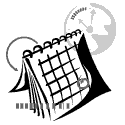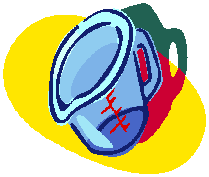First grade math consists of a variety of skills including concepts,
computation, and problem solving. The more the students practice these
skills, the more proficient they become in math. Our math routine includes
our morning meeting at the calendar each morning, daily fact practice, a
lesson with hands on learning, as well as written practice.
Calendar skills
We begin each day with a fifteen minute morning meeting. During this meeting we update our class 
calendar and work on a variety of skills which revolve around the calendar. You can help prepare
your child for this by discussing the day of the week in terms of yesterday, today, and tomorrow on
the way to school. The students need to know there are 7 days in a week, 12 months in a year, and
365 days in a year. They also need to know how to find the date on the calendar.
We practice counting to one hundred by ones, twos, fives, and tens forwards and backwards.
We record the weather on the weather graph and record this information in our daily news.
Math Facts
The mastery of addition and subtraction facts is a vital part of success in first grade. The class practices
daily using flashcards, drill sheets, reviewing charts with numbers concepts and addition and subtraction
strategies. Students make and receive flashcards each time a new set of facts is introduced to take home
and practice. The students are taught a variety of strategies to find solutions to all problems and are
encouraged to use the strategy that works best for them. I focus on touch math (adding or subtracting
by counting up or back using dots placed strategically on numbers) and using number sense.
Number sense is a thorough understanding of how numbers work. It is really helpful for
students to have a basic understanding of number concepts such as:
-
adding zero: anytime zero is added to a number the answer stays the same
-
adding one: anytime one is added to a number the sum is the next number
-
adding two: anytime two is added to a number, you count up two from the higher number
-
adding ten: when ten is added to a number, the number in the ones place stays the same and the number in the tens places goes up 1
-
doubles: adding matching addends (ex: 1+1, 2+2, 3+3) these are memorized because they are easy to remember
-
doubles plus one: adding numbers to numbers that are one more than the other addend (ex: 1+2, 2+3, 3+4)
When adding sums of ten, the order of the number does not matter, you can always count up by saying the higher number and counting up.
-
subtracting zero: when zero is subtracted from a number, the difference is the top number
-
subtracting one: when one is subtracted from a number, you count back one
There are several links to fun sites to practice facts on the Students and Games People Play pages.
If your child uses their fingers to add and subtract, and that is the strategy they feel the most comfortable using,
I would never try to stop them. First graders should be able to add and subtract two digit numbers without regrouping.
Money
First graders should know the value of a penny, nickel, dime, quarter, half dollar, and dollar.
First graders should be able to count money using pennies, nickels, dimes, and quarters.
Please practice counting pennies, nickels, and dimes with your child.
If it is difficult then begin with just pennies, then go to pennies and dimes, then pennies, dimes, and nickels.
Just letting you child count the change left in your pocket at the end of the day is better than no practice.
Don't let them talk you into giving your change to them, or they will expect it every night, and the next thing
you know they are rich and you are broke.
Time: First graders should be able to tell time to the hour and half hour on an analog and digital clock. 
First graders should be able to say the time to the half hour as half past the hour or as (hour)thirty.
Fractions
First graders should be able to recognize one-half, one-third, and one-fourth fractions.
Story Problems
First graders should be able to solve story problems with addition or subtraction.
You can help practice these skills by helping your child make up stories about
household objects.
For example: I had two cookies.
I ate one.
How many cookies do I have left? Let them tell you the number sentence. 2-1=1
Measurement 
First graders should be able to measure using nonstandard units (measuring in paper clips), centimeters, and inches.
First graders should also be able to recognize the best scale for objects by size.
Place Value
First graders should be able to identify the place value of numbers to the hundreds place.
(For example: the number in the tens place of 267 is 6)
This is one of the more difficult skills for first graders. You can practice by asking them what number
is in either the hundereds, tens, or ones place in two and three digit numbers.
|